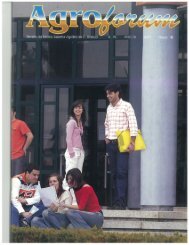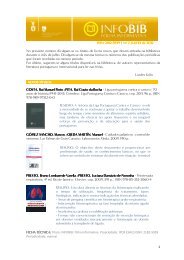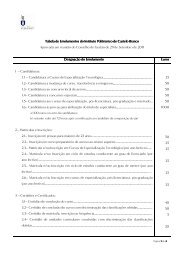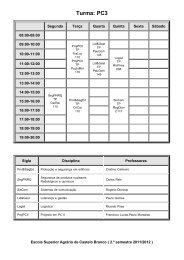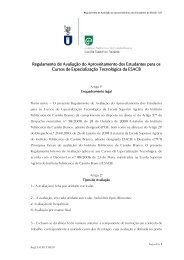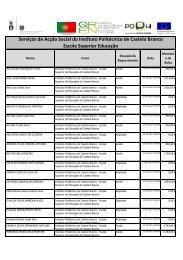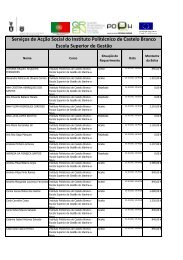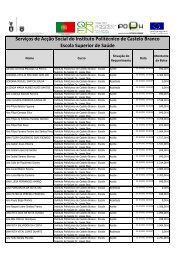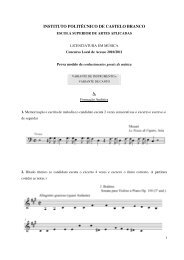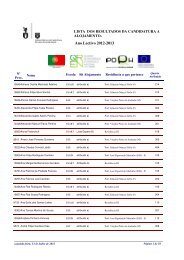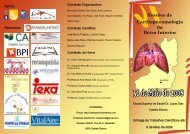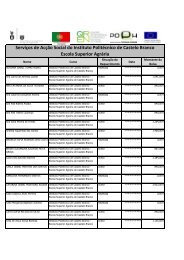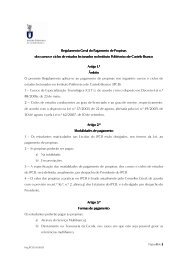N.º 24 - PDF - Instituto Politécnico de Castelo Branco
N.º 24 - PDF - Instituto Politécnico de Castelo Branco
N.º 24 - PDF - Instituto Politécnico de Castelo Branco
Create successful ePaper yourself
Turn your PDF publications into a flip-book with our unique Google optimized e-Paper software.
3. Specific problems on the cultivation<br />
MAPs has a particular context because the most of the<br />
species of this group of plants doesn’t have good agricultural<br />
practices, so the estimation of the real production in the<br />
different countries it’s difficult.<br />
Due to the recent political and economical <strong>de</strong>velopment<br />
of Eastern European countries it is not to be expected that<br />
domestication of wild MAP has any priority there. This<br />
should be a challenge for Mediterranean countries. The list<br />
of candidate plants to be domesticated has increased. Species<br />
like Achillea millefolium; Arnica montana; Artemisia<br />
annua; Chelidonium majus; Echinacea sp.; Genciana lutea<br />
and Valeriana edulis among others, are examples of medicinal<br />
plants domesticated within the last <strong>de</strong>ca<strong>de</strong>s.<br />
In Portugal which are the species to explore?<br />
Limonete (Aloysia triphylla); Mint-pepper (Menthaxpiperita);<br />
Herb-prince (Cymbopogon citratus); Balm-mint<br />
(Melissa officinalis); Thyme-lemon (Thymus x citriodorus);<br />
Laurel (Laurus nobilis);Equinácea (Echinacea sp.).<br />
The market presents however flotation in the search of<br />
some of these species, that are arrested above all with the<br />
world offer in certain moment.<br />
The farmer should be prepared to face those flotation,<br />
tends enough elasticity to bet in a new species, more lucrative,<br />
in a short space of time.<br />
4. Good agricultural practices<br />
for MAPs<br />
4.1. I<strong>de</strong>ntification/autentication of<br />
cultivated MAPs<br />
4.1.1. Selection of medicinal plants<br />
The species or botanical variety for cultivation should<br />
be the same as the specified in the national pharmacopoeia<br />
or recommen<strong>de</strong>d by other authoritative national documents<br />
to the end-user’s country.<br />
4.1.2. Botanical i<strong>de</strong>ntity<br />
The botanical i<strong>de</strong>ntity- scientific name of each medicinal<br />
plant un<strong>de</strong>r cultivation should be recor<strong>de</strong>d.<br />
4.2. Seeds and other propagation<br />
material<br />
Seeds and other propagation materials should be specified.<br />
This material used for organic production should be<br />
certified as being organically <strong>de</strong>rived.<br />
4.3. Cultivation<br />
Cultivation of MAP requires intensive care and management.<br />
The conditions and duration of cultivation required<br />
vary <strong>de</strong>pending on the quality of medicinal, aromatic<br />
or spice materials required. Since this is not an agricultural<br />
manual. Emphasis are placed on methods of growing that,<br />
without use of substances which damage the environment,<br />
will provi<strong>de</strong> a reasonable supply of natural products for<br />
household, and medicinal uses.<br />
Conservation Agriculture (CA) techniques should be<br />
followed where appropriate, especially in the build-up of<br />
organic matter and conservation of soil humidity.<br />
4.3.1. Site selection<br />
Medicinal plant materials <strong>de</strong>rived from the same<br />
species can show significant differences in quality when<br />
cultivated at different sites, owing to the influence of<br />
soil, climate and other factors. These differences may<br />
related to physical appearance or to variations in their<br />
constituents, the biosynthesis of which may be affected<br />
by extrinsic environmental conditions, including ecological<br />
and geographical variables, and should be taken<br />
into consi<strong>de</strong>ration.<br />
Risk of contamination as a result of pollution of<br />
the soil, air or water by hazardous chemicals should be<br />
avoi<strong>de</strong>d. The impact of past land uses on the cultivation<br />
site, including the planting of previous crops and<br />
any applications of plant protection products should be<br />
evaluated.<br />
4.3.2. Ecological environment and social<br />
impact<br />
The cultivation of MAP may affect the ecological balance<br />
and, in particular, the genetic diversity of the flora<br />
and fauna in surrounding habitats. The quality and the<br />
growth of medicinal plants can also be affected by other<br />
plants, other living organisms and by human activities. The<br />
introduction of non-indigenous medicinal plant species<br />
into cultivation may have a <strong>de</strong>trimental impact on the biological<br />
and ecological balance of the region.<br />
The social impact of cultivation on local communities<br />
should be examined to ensure that negative impacts on local<br />
livelihood are avoi<strong>de</strong>d. In terms of local income-earning<br />
opportunities, small-scale cultivation is often preferable to<br />
large-scale production, in particular if small-scale farmers<br />
are organized to market their products jointly.<br />
n.º <strong>24</strong> Ano 18, 2010 7



